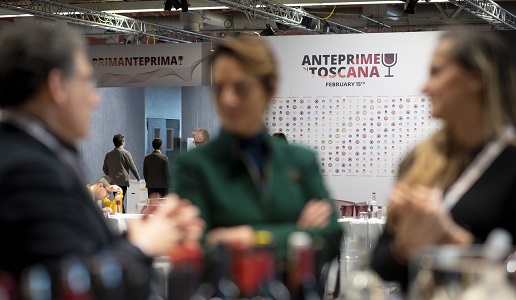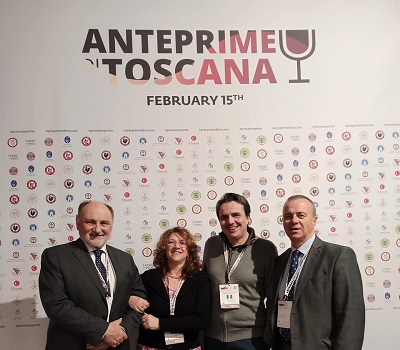The 2020 Tuscany Preview week is open

Presented at PrimAnteprima of data on production and export of Tuscan wines. The United States and Germany confirm themselves as the greatest lovers of regional DOC and DOCG wines, importing over 50% of total exports, but the Far East is gaining market share. Production is increasing, prices are holding up and more and more is being invested in innovation and sustainability, also in wine tourism.
More than half of Tuscany's DOC and DOCG certified production flies to foreign markets, accounting for about 19% of total exports of national PDO still wines, a share that rises to 26% if you consider the value. The figure emerges from the Ismea research presented in Florence during the round table for the inauguration of the 2020 Preview Week, held as part of PrimAnteprima, a regional collective promoted by the Region of Tuscany together with the Florence Chamber of Commerce and organized by PromoFirenze, the Special Agency of the Florence Chamber of Commerce and Fondazione Sistema Toscana.
Exports of Tuscan PDO wines are growing (+3% in the first 10 months of 2019), while the basin of importing countries is expanding. If the United States and Germany confirm themselves as the two main destination countries and together absorb more than 50% of the market (both in terms of volume and value), the Far East gains important shares. Between 2010 and 2014, in fact, only 1% of the product was shipped to China, while in the second half of the decade it exceeded 2%. Japan also increased slightly, from 2.7% to 3.2%. Demand in Hong Kong, Singapore and Taiwan also increased significantly, although in absolute terms the weight in value rose from 0.6 to 1 %. Eastern Europe, with Russia in the lead, shows a fair attention to Tuscan denominations, but maintains a marginal role. The trend is positive in Brazil, Mexico, Australia and New Zealand.
SCENARIANS
Numbers that bode well, despite the unknowns represented by the threat of U.S. duties (fortunately for now returned), the first importer of Tuscan wines, the Brexit and Coronavirus alarm, as well as the significant slowdown in the German economy. For the moment, however, the Made in Tuscany wine industry is holding its own, also from the point of view of prices, despite the fact that 2019 has seen a setback after 10 years of substantial increases.
PRODUCTION
There are 58 awards between PDO (52) and PGI (6) that affect regional production, for an annual production of 2.1 million hectoliters on average (about 11% of Italian PGI production): of the approximately 59 thousand hectares of Tuscan vineyards, 56 thousand are allocated to certified designations, for a percentage of 96%, which far exceeds the national average of 62%. The 2019 harvest also goes against the trend: according to data released by Artea, Tuscan production stands at 2.6 million hectolitres, with an increase of 11% compared to the previous year, while at a national level there is a drop of 19% (Ismea/Uiv estimate).
VALUE
Translating volumes into value, limited to Ig wines, Ismea estimates that bottled production is worth a total of almost one billion Euros: about 793 million Euros for PDOs to which 168 million PGIs are added (2018 estimate).

These data were all presented at the round table LA VISION 2030 DELLA TOSCANA DEL VINO: MERCATI, ENOTURISMO E INNOVAZIONE, the central moment of PrimAnteprima, which was attended, together with the Councillor for Agriculture of the Tuscany Region Marco Remaschi, Fabio del Bravo of ISMEA, Francesco Mazzei president of Avito, Donatella Cinelli Colombini president of Consorzio Vino Orcia and Roberto Scalacci of the Tuscany Region. Finally, Professor Attilio Scienza, Professor of Viticulture at the University of Milan, fascinated the public with the story of the oenological experiment that has retraced, after 2,500 years, the production of the legendary wine of the island of Chios: Nesos, made on the island of Elba by the Arrighi winery in the manner of the ancient Greeks.
INNOVATION AND SUSTAINABILITY
While maintaining its charm intact, the Tuscan vineyard stands out for its liveliness, dynamism and strong orientation towards innovation. In this regard, it is worth mentioning the ability to make effective use of the funds made available by the European Union: half of the regional vineyard has benefited from the Restructuring and Conversion measure (28 thousand hectares), while in the 10 years of application of the Promotion on third markets 352 projects have been financed for an expenditure of 86 million euros. Innovation is increasingly linked to the theme of the sustainability of Tuscan wine production: overall, 26 regional integrated supply chain projects financed through the 2014-2020 RDP have been financed, for a contribution of over 6.5 million euros. Many of these projects provide for the application of the criteria of "Precision Viticulture", which allow a significant reduction in the use of fertilizers and pesticides. These include the "SOS-NOBIL-ETÀ" project, coordinated by the Vecchia Cantina di Montepulciano, which has experimented for the first time with the creation of a collaborative platform for the self-assessment of the environmental sustainability of its company and obtain information on the best technologies with low environmental impact; "SOS.T.", coordinated by Cantina di Pitigliano, which allowed 4 Tuscan companies (including Cantina di Pitigliano and Cantina Vini di Maremma) to be certified according to the Equalitas-Vino Sostenibile standard, which guarantees social and ethical, as well as environmental sustainability.
ENOTURISM
Finally, the project of the Consortium for the protection of wine with denomination of origin Orcia was born to combine production and tourism, transforming the cellars into places of shopping, culture, experience and experimenting with a reproducible model. The proposal is simple but revolutionary: wine is transformed into a postcard to be tasted, able to enrich the journey, tell the story of the territory, enhance the local export market of an entire piece of the region. In the Val d'Orcia, thanks to the integrated supply chain project of the Region of Tuscany, a project is underway to bring tourists closer to the wine of the denomination, serving it in an appropriate way: a series of wine cellars will be distributed free of charge throughout the territory (including wineries, supermarkets, wine shops, restaurants and wine bars) and will allow them to taste a glass at the optimal temperature, while at the same time knowing the information about the producer and the history of the wine. The project aims to enhance what in the Val d'Orcia, recognized at UNESCO level for its beauty, is called "the export on the doorstep", i.e. the presence all year round of international tourism. But the growing union between wine and tourism concerns the whole region: it is no coincidence that Tuscany was the first region to adopt a specific law, declining the national indications contained in the DM of 12 March 2019 on the subject of wine tourism.
THE WINE WEEK
Reserved for professionals and the international trade press, PrimAnteprima is the opening gala of the Tuscan Wine Week, with the opportunity to taste the vintages just released by the emerging Consortia of the region: Carmignano, Chianti Rufina, Colline Lucchesi, Maremma Toscana, Montecucco, Orcia, Terre di Pisa and Valdarno di Sopra. The Preview Week program will continue with Chianti Lovers by the Consorzio Vino Chianti and Morellino di Scansano (February 16, Fortezza da Basso), Chianti Classico Collection by the Consorzio Vino Chianti Classico (17-18, Stazione Leopolda in Florence), Preview Vernaccia di San Gimignano by Consorzio del Vino Vernaccia di San Gimignano (19 February, San Gimignano), Preview Vino Nobile di Montepulciano by Consorzio del Vino Nobile di Montepulciano (20 February, Montepulciano), Benvenuto Brunello 2020 by Consorzio del Vino Brunello di Montalcino (21 and 22 February, Montalcino).
For more info www.buy-wine.it and www.anteprimetoscane.it.

 Italiano
Italiano







